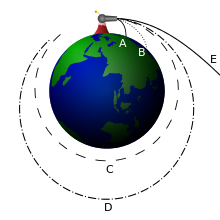Ballistics
Ballistics the study of the motion of projectiles (flying objects), mainly about bullets which are fired from guns or cannon, but also about the motion of spacecrafts, motion of balls in ball games, etc. The motion of projectiles can be expressed by trajectories, which are the paths which a projectile takes. This science shows us the path and behavior of projectiles. Gun ballistics may be divided into the following four categories.[1]

- Internal ballistics is about the motion of projectile inside barrel (tube part of gun). This motion depends on the pressure of gas, which is created by burning gunpowder. The pressure is depends on (is related to) the amount of gunpowder in the bullet, the type of gunpowder, size of pieces of gunpowder, free space behind a bullet and outside temperature. This motion also depends on the size and weight of bullet. The most important number from internal ballistics for performance is the muzzle velocity (projectile speed from the front edge of barrel).
- Transition ballistics is the study about the behavior and changes in a nearby distance from the barrel. It studies the effect of gases going from a barrel behind a bullet, which are faster than bullet. These gases can affect the ballistic path, usually in a bad way.
- External ballistics studies the trajectory of a projectile when it is outside of the object which accelerates it (such as when a bullet leaves the barrel of the gun, from which it is fired). This trajectory depends on three ballistic conditions - the beginning speed, the angle at which the object is thrown, and the ballistic coefficient (a number, which describes the influences of the air on the object). Trajectory of a projectile is also influenced by (depends on) resistance of air, rotation of bullet, the density and pressure of the air, and the strength and direction in which the wind may be blowing. For long-distance missiles, they also have to consider the changes in the magnetic field of the Earth.
- Terminal ballistics is about what happens when the projectile hits something, and either comes to a stop, or bounces off the other object.
References[change | change source]
Wikimedia Commons has media related to Ballistics.
- ↑ U.S. Marine Corps (1996). FM 6-40 Tactics, Techniques, and Procedures for Field Artillery Manual Cannonry. Department of the Army.
